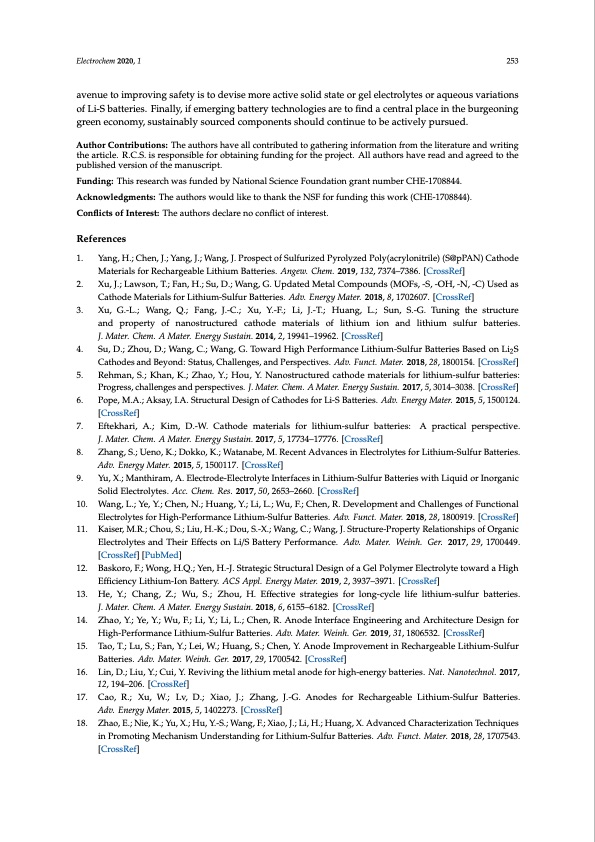
PDF Publication Title:
Text from PDF Page: 028
Electrochem 2020, 1 253 avenue to improving safety is to devise more active solid state or gel electrolytes or aqueous variations of Li-S batteries. Finally, if emerging battery technologies are to find a central place in the burgeoning green economy, sustainably sourced components should continue to be actively pursued. Author Contributions: The authors have all contributed to gathering information from the literature and writing the article. R.C.S. is responsible for obtaining funding for the project. All authors have read and agreed to the published version of the manuscript. Funding: This research was funded by National Science Foundation grant number CHE-1708844. Acknowledgments: The authors would like to thank the NSF for funding this work (CHE-1708844). Conflicts of Interest: The authors declare no conflict of interest. References 1. Yang, H.; Chen, J.; Yang, J.; Wang, J. Prospect of Sulfurized Pyrolyzed Poly(acrylonitrile) (S@pPAN) Cathode Materials for Rechargeable Lithium Batteries. Angew. Chem. 2019, 132, 7374–7386. [CrossRef] 2. Xu, J.; Lawson, T.; Fan, H.; Su, D.; Wang, G. Updated Metal Compounds (MOFs, -S, -OH, -N, -C) Used as Cathode Materials for Lithium-Sulfur Batteries. Adv. Energy Mater. 2018, 8, 1702607. [CrossRef] 3. Xu, G.-L.; Wang, Q.; Fang, J.-C.; Xu, Y.-F.; Li, J.-T.; Huang, L.; Sun, S.-G. Tuning the structure and property of nanostructured cathode materials of lithium ion and lithium sulfur batteries. J. Mater. Chem. A Mater. Energy Sustain. 2014, 2, 19941–19962. [CrossRef] 4. Su, D.; Zhou, D.; Wang, C.; Wang, G. Toward High Performance Lithium-Sulfur Batteries Based on Li2S Cathodes and Beyond: Status, Challenges, and Perspectives. Adv. Funct. Mater. 2018, 28, 1800154. [CrossRef] 5. Rehman, S.; Khan, K.; Zhao, Y.; Hou, Y. Nanostructured cathode materials for lithium-sulfur batteries: Progress, challenges and perspectives. J. Mater. Chem. A Mater. Energy Sustain. 2017, 5, 3014–3038. [CrossRef] 6. Pope, M.A.; Aksay, I.A. Structural Design of Cathodes for Li-S Batteries. Adv. Energy Mater. 2015, 5, 1500124. [CrossRef] 7. Eftekhari, A.; Kim, D.-W. Cathode materials for lithium-sulfur batteries: A practical perspective. J. Mater. Chem. A Mater. Energy Sustain. 2017, 5, 17734–17776. [CrossRef] 8. Zhang, S.; Ueno, K.; Dokko, K.; Watanabe, M. Recent Advances in Electrolytes for Lithium-Sulfur Batteries. Adv. Energy Mater. 2015, 5, 1500117. [CrossRef] 9. Yu, X.; Manthiram, A. Electrode-Electrolyte Interfaces in Lithium-Sulfur Batteries with Liquid or Inorganic Solid Electrolytes. Acc. Chem. Res. 2017, 50, 2653–2660. [CrossRef] 10. Wang, L.; Ye, Y.; Chen, N.; Huang, Y.; Li, L.; Wu, F.; Chen, R. Development and Challenges of Functional Electrolytes for High-Performance Lithium-Sulfur Batteries. Adv. Funct. Mater. 2018, 28, 1800919. [CrossRef] 11. Kaiser, M.R.; Chou, S.; Liu, H.-K.; Dou, S.-X.; Wang, C.; Wang, J. Structure-Property Relationships of Organic Electrolytes and Their Effects on Li/S Battery Performance. Adv. Mater. Weinh. Ger. 2017, 29, 1700449. [CrossRef] [PubMed] 12. Baskoro, F.; Wong, H.Q.; Yen, H.-J. Strategic Structural Design of a Gel Polymer Electrolyte toward a High Efficiency Lithium-Ion Battery. ACS Appl. Energy Mater. 2019, 2, 3937–3971. [CrossRef] 13. He, Y.; Chang, Z.; Wu, S.; Zhou, H. Effective strategies for long-cycle life lithium-sulfur batteries. J. Mater. Chem. A Mater. Energy Sustain. 2018, 6, 6155–6182. [CrossRef] 14. Zhao, Y.; Ye, Y.; Wu, F.; Li, Y.; Li, L.; Chen, R. Anode Interface Engineering and Architecture Design for High-Performance Lithium-Sulfur Batteries. Adv. Mater. Weinh. Ger. 2019, 31, 1806532. [CrossRef] 15. Tao, T.; Lu, S.; Fan, Y.; Lei, W.; Huang, S.; Chen, Y. Anode Improvement in Rechargeable Lithium-Sulfur Batteries. Adv. Mater. Weinh. Ger. 2017, 29, 1700542. [CrossRef] 16. Lin, D.; Liu, Y.; Cui, Y. Reviving the lithium metal anode for high-energy batteries. Nat. Nanotechnol. 2017, 12, 194–206. [CrossRef] 17. Cao, R.; Xu, W.; Lv, D.; Xiao, J.; Zhang, J.-G. Anodes for Rechargeable Lithium-Sulfur Batteries. Adv. Energy Mater. 2015, 5, 1402273. [CrossRef] 18. Zhao, E.; Nie, K.; Yu, X.; Hu, Y.-S.; Wang, F.; Xiao, J.; Li, H.; Huang, X. Advanced Characterization Techniques in Promoting Mechanism Understanding for Lithium-Sulfur Batteries. Adv. Funct. Mater. 2018, 28, 1707543. [CrossRef]PDF Image | Lithium-Sulfur Batteries: Advances and Trends

PDF Search Title:
Lithium-Sulfur Batteries: Advances and TrendsOriginal File Name Searched:
electrochem-01-00016.pdfDIY PDF Search: Google It | Yahoo | Bing
Sulfur Deposition on Carbon Nanofibers using Supercritical CO2 Sulfur Deposition on Carbon Nanofibers using Supercritical CO2. Gamma sulfur also known as mother of pearl sulfur and nacreous sulfur... More Info
CO2 Organic Rankine Cycle Experimenter Platform The supercritical CO2 phase change system is both a heat pump and organic rankine cycle which can be used for those purposes and as a supercritical extractor for advanced subcritical and supercritical extraction technology. Uses include producing nanoparticles, precious metal CO2 extraction, lithium battery recycling, and other applications... More Info
| CONTACT TEL: 608-238-6001 Email: greg@infinityturbine.com | RSS | AMP |